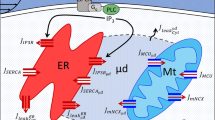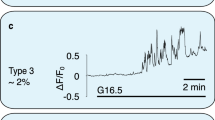Abstract
In the stressed animal, the vasoactive hormones vasopressin and angiotensin-II and the neurotransmitter noradrenaline induce liver cells to release glucose from glycogen. The intracellular signal that links the cell-surface receptors for noradrenaline (α1) and vasoactive peptides to activation of glycogenolysis is known to be a rise in the cytoplasmic concentration of free calcium ions (free Ca)1–3. The receptors for these agonists induce the hydrolysis of phosphatidylinositol 4,5-bisphosphate, a minor plasmalemma lipid, to produce inositol trisphosphate and diacylglycerol3–5. Inositol trisphosphate has been shown to mobilize intracellular calcium in hepatocytes3,6–8. We show here, by means of aequorin measurements in single, isolated rat hepatocytes, that the free Ca response to these agonists consists of a series of transients. Each transient rose within 3 s to a peak free Ca of at least 600 nM and had a duration of approximately 7 s. The transients were repeated at intervals of 0.3–4 min, depending on agonist concentration. Between transients, free Ca returned to the resting level of ˜200nM. Clearly, the mechanisms controlling free Ca in hepatocytes are more complex than hitherto suspected.
This is a preview of subscription content, access via your institution
Access options
Subscribe to this journal
Receive 51 print issues and online access
$199.00 per year
only $3.90 per issue
Buy this article
- Purchase on Springer Link
- Instant access to full article PDF
Prices may be subject to local taxes which are calculated during checkout
Similar content being viewed by others
References
Murphy, E., Coll, K., Rich, T. L. & Williamson, J. R. J. biol Chem. 255, 6600–6608 (1980).
Charest, R., Blackmore, P. F., Berthon, B. & Exton, J. H. J. biol. Chem. 258, 8769–8773 (1983).
Thomas, A. P., Alexander, J. & Williamson, J. R. J. biol. Chem. 259, 5574–5584 (1984).
Creba, J. et al. Biochem. J. 212, 733–747 (1983).
Williamson, J. R., Cooper, R. H., Joseph, S. K. & Thomas, A. P. Am. J. Physiol. 248, C203–C216 (1985).
Berridge, M. J. & Irvine, R. F. Nature 312, 315–321 (1984).
Burgess, G. M., Irvine, R. F., Berridge, M. J., McKinney, J. S. & Putney, J. W. Biochem. J. 224, 741–746 (1984).
Joseph, S. K., Thomas, A. P., Williams, R. J., Irvine, R. F. & Williamson, J. R. J. biol. Chem. 259, 3077–3081 (1984).
Cruise, J. L., Houck, K. A. & Michalopoulos, G. K. Science 227, 749–751 (1985).
Kirk, C. J., Rodrigues, L. M. & Hems, D. A. Biochem. J. 178, 493–496 (1979).
Campanile, C. P., Crane, J. K., Peach, M. J. & Garrison, J. C. J. biol. Chem. 257, 4951–4958 (1982).
Cooper, R. H., Coll, K. E. & Williamson, J. R. J. biol. Chem. 260, 3281–3288 (1985).
Kirk, C. J., Creba, J. A., Downes, C. P. & Michell, R. H. Biochem. Soc. Trans. 9, 377–379 (1981).
Kirk, C. J. Cell Calcium 3, 399–411 (1982).
Chrisman, T. D., Jordan, J. F. & Exton, J. H. J. biol. Chem. 257, 10798–10804 (1982).
Erdödi, F., Gergely, P. & Bot, G. Int. J. Biochem. 16, 1391–1394 (1984).
Rasmussen, H. & Barrett, P. Q. Physiol. Rev. 64, 938–984 (1984).
Campbell, A. K. Intracellular Calcium, Its Universal Role as Regulator (Wiley, Chichester, 1983).
Berridge, M. J. & Prince, W. T. J exp. Biol. 56, 139–153 (1972).
Matthews, E. K. & O'Connor, M. D. L. J exp. Biol. 81, 75–91 (1979).
Cuthbertson, K. S. R., Whittingham, D. G. & Cobbold, P. H. Nature 294, 754–757 (1981).
Poeinie, M., Alderton, J., Tsien, R. Y. & Steinhardt, R. A. Nature 315, 147–149 (1985).
Cuthbertson, K. S. R. & Cobbold, P. H. Nature 316, 541–542 (1985).
Burgess, G. M., Claret, M. & Jenkinson, D. H. J. Physiol., Lond. 317, 67–90 (1981).
Cobbold, P. H., Cuthbertson, K. S. R., Goyns, M. M. & Rice, V. R. J. Cell Sci. 61, 123–136 (1983).
Cobbold, P. H. & Bourne, P. K. Nature 312, 444–446 (1984).
Author information
Authors and Affiliations
Rights and permissions
About this article
Cite this article
Woods, N., Cuthbertson, K. & Cobbold, P. Repetitive transient rises in cytoplasmic free calcium in hormone-stimulated hepatocytes. Nature 319, 600–602 (1986). https://doi.org/10.1038/319600a0
Received:
Accepted:
Issue Date:
DOI: https://doi.org/10.1038/319600a0
This article is cited by
-
Universality in bio-rhythms: A perspective from nonlinear dynamics
Journal of Biosciences (2022)
-
Blood-brain barrier permeability and physical exercise
Journal of Neuroinflammation (2019)
-
Modeling the role of endoplasmic reticulum-mitochondria microdomains in calcium dynamics
Scientific Reports (2019)
-
Determining the Roles of Inositol Trisphosphate Receptors in Neurodegeneration: Interdisciplinary Perspectives on a Complex Topic
Molecular Neurobiology (2017)
-
Real-time quantification of protein expression and translocation at individual cell resolution using imaging-dish-based live cell array
Analytical and Bioanalytical Chemistry (2014)
Comments
By submitting a comment you agree to abide by our Terms and Community Guidelines. If you find something abusive or that does not comply with our terms or guidelines please flag it as inappropriate.



